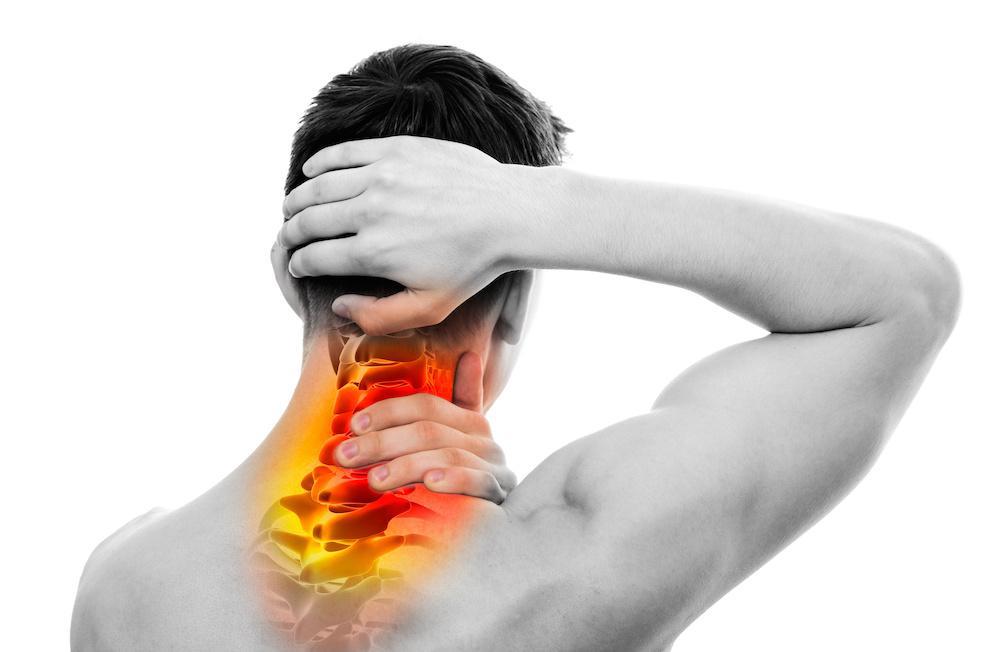McHenry Neck Pain Treatment
What is neck pain
Neck pain is a pain in or around the spine beneath your head, the cervical spine. Neck pain is a common symptom of many different injuries and medical conditions. Poor posture, caused by leaning over a computer, improper sleeping, or hunching over a workbench, strains neck muscles. Osteoarthritis also is a common cause of neck pain. Neck pain can interfere with daily activities and reduce your quality of life if left untreated.
Some common types of neck pain are axial and radicular neck pain. Axial neck pain is felt mostly in the neck and radicular neck pain is pain shooting into other areas such as the shoulders or arms. Neck pain can be acute (lasting from days to weeks) or chronic (lasting longer than 3 months to years).
Rarely, neck pain can be a symptom of a more serious problem. You should seek medical care for neck pain with numbness or loss of strength in the arms or hands or for pain that shoots down your shoulder or arm. Most neck pain can be treated by an experienced McHenry physical therapist.

Jump to a Section
- Symptoms of neck pain
- Causes of neck pain
- Neck pain diagnosis
- Neck pain treatment
- Non-surgical treatment
- Neck pain prevention
- How physical therapy can help
- Goals of physical therapy
- When physical therapy is recommended
- Treatment methods
- Contact us
Symptoms of neck pain
Neck pain symptoms can range in severity and duration. Our McHenry patient’s neck pain may be mild and not interfere much with their activities or daily living, or it may be severe and cause disability. Some examples of mild neck pain would be pain that gets worse when you hold your head a certain way while working on a computer, driving, or doing other tasks and muscle tightness or spasms.
Common symptoms of neck pain in McHenry patients may include:
Stiff neck
People with neck pain often describe feeling as though their neck is “stiff” or “stuck.” Neck pain can sometimes cause a decreased range of motion.
Sharp pain
Neck pain may feel like sharp or “stabbing” pain that is localized to one area.
Pain when moving
Often exacerbated by moving, twisting, or extending your cervical spine, either from side to side or up and down.
Radiating pain or numbness
Your neck pain may radiate to your head, shoulder, and arms. If your neck pain involves the compression of a nerve, you may feel numbness, tingling, or weakness in either of your arms or hands. Neck pain that is from a pinched nerve may feel like a burning or sharp pain that starts at the neck and travels down the arm. Talk with a McHenry physical therapist if you experience this symptom.
Headache
Pain that starts in your neck may also produce a headache. Neck pain with a headache may also be a symptom of a migraine headache.
Pain when palpated
Neck pain may increase if your cervical spine is palpated (physically examined).
Causes of neck pain

Your neck can be at risk of injuries and conditions that cause pain and restrict motion because the neck supports the weight of the head. Neck pain causes include:
- Car accidents involving whiplash
- Arthritis – swelling and tenderness of one or more joints.
- Infection
- Tumors – An abnormal mass of tissue that forms when cells grow and divide more than they should or do not die when they should.
- A fractured or collapsed vertebra, which can be related to osteoporosis
- Fibromyalgia – a disorder characterized by widespread musculoskeletal pain accompanied by fatigue, sleep, memory and mood issues.
- Narrowed spaces within your spine (spinal stenosis)
- Muscle strains. Overuse, such as too many hours hunched over a computer or a smartphone, often triggers muscle strains. Even minor things, such as reading in bed, can strain neck muscles.
- Worn joints. As with other joints in the body, neck joints tend to wear with age. In response to this wear and tear, the body often forms bone spurs that can affect joint motion and cause pain.
- Nerve compression. Herniated disks or bone spurs in the vertebrae of the neck can press on the nerves branching out from the spinal cord.
- Injuries. Rear-end auto collisions often result in whiplash injury. This occurs when the head jerks backward and then forward, straining the soft tissues of the neck.
- Diseases. Certain diseases, such as rheumatoid arthritis, meningitis or cancer, can cause neck pain.
- Aging: Degenerative conditions such as osteoarthritis (the wearing down of joint cartilage) and spinal stenosis (narrowing of the spaces in the spine) can lead to neck pain as you age. Over time, stress and motion can lead to spinal disc degeneration, causing a herniated disc or pinched nerve.
- Mental stress: Tightening your neck muscles due to tension commonly causes neck pain and stiffness.
McHenry Neck pain diagnosis
Diagnosis is made by a neurosurgeon near you based on patient history, symptoms, a physical examination, and results of diagnostic studies, if necessary. Some McHenry patients may be treated conservatively and then undergo imaging studies if medication and McHenry physical therapy are ineffective. These tests may include: Your doctor will feel and move your neck to locate pain and find motion problems. Doctors also check your muscle strength and reflexes. Your McHenry therapist will ask about previous neck injuries that might have caused whiplash or a herniated disc. Your McHenry physical therapist near you may ask about work or other activities that could affect your neck. In addition, here are a few tests which you may need to diagnose neck pain:
- Computed Tomography Scan (CT or CAT scan)
- Discography
- Electromyography (EMG)
- Nerve Conduction Studies (NCS)
- Magnetic Resonance Imaging (MRI)
- X-rays
These tests can show damage and other issues in the bones and surrounding tissues in your neck. The tests look more closely at the discs in the spine, the spine itself, and check the function of nerves and muscle response and the source of the pain.
See your physical therapist near you right away if your neck hurts after a fall or an accident, or if the pain is intense, doesn’t respond to treatment, gets worse over time, or includes numbness, weakness, or tingling and pain in your arms and legs.
Your nearby McHenry physical therapist may ask:
- When did the pain start?
- Have you been injured?
- Do you have numbness or weakness in your arms or hands?
- Does moving your neck in a certain way make things better or worse?
- Does coughing or sneezing make the pain worse?
Neck pain treatment

A McHenry physical therapist near you will perform a physical exam and take your complete medical history. Be prepared to tell them about the specifics of your neck pain symptoms. Let the experienced therapist know about all prescription and over-the-counter (OTC) medications and supplements you’ve been taking. Even if it doesn’t seem related, let your doctor know about any recent injuries, such as hamstring pulls or knee pain, or accidents you’ve had.
Depending on the results, your experienced physical therapist may refer you to a specialist. Treatment for neck pain may include:
- ice and heat therapy
- exercise, stretching, and physical therapy
- pain medication
- corticosteroid injections
- muscle relaxants
- neck collar
- traction
- antibiotics if you have an infection
- hospital treatment, if a condition such as meningitis or heart attack is the cause
- surgery, which is rarely necessary
Treatments could include medications such as muscle relaxants, more physical therapy, a padded neck collar, or traction.
In rare situations, you may need shots of cortisone or even surgery.
With proper treatment, your neck pain will usually stop hurting in a few days. Use medicines such as acetaminophen, aspirin, or ibuprofen to ease pain. Put an ice pack on your neck for the first 2 to 3 days to help lower swelling. After, use moist heat, like a hot shower or a heating pad, to help your neck heal. There are also exercises you can do at home (or in front of your computer at work) to gently stretch your neck muscles.
Treatment for neck pain varies depending on the cause. It aims to relieve pain and improve function. Many treatment plans for persistent neck pain include some form of McHenry physical therapy to improve neck strength and flexibility. The physical therapy program’s structure and length can vary depending on the specific diagnosis and situation. Multiple sessions per week with a trained physical therapist may be recommended to start. In time, prescribed exercises may be continued at home.
Non-Surgical Treatments
Most causes of neck pain are not life threatening and resolve with time and conservative medical treatment, such as McHenry physical therapy. Determining a treatment strategy depends mainly on identifying the location and cause of the pain. Although neck pain can be quite debilitating and painful, nonsurgical management can alleviate many symptoms. Your nearby physical therapist may prescribe medications to reduce the pain or inflammation and muscle relaxants to allow time for healing to occur. Reducing physical activities or wearing a cervical collar may help provide support for the spine, reduce mobility and decrease pain and irritation. Trigger point injection, including corticosteroids, can temporarily relieve pain. Occasionally, epidural steroids may be recommended. Conservative treatment options may continue for six to eight weeks.
If neck pain is not debilitating and was not caused by trauma, the pain can typically be treated with self-care.
- Short period of rest. While strenuous activities and movements that worsen pain are to be avoided for a few days, some movement is typically encouraged to prevent the neck from becoming weaker and/or stiffer.
- Ice and/or heat. Applying ice can help reduce swelling and pain. Applying heat may help relax muscles and bring more blood flow and healing nutrients to the injured area. For ice or heat therapy, applications are limited to 15 or 20 minutes with at least a 2-hour break in between to give the skin time to recover.
Gentle stretches. Some forms of neck pain or muscle tightness are alleviated with gentle range-of-motion stretches. If a particular movement or stretch exacerbates pain, stop and try another movement instead.
Neck pain prevention
Most neck pain is associated with poor posture combined with age-related wear and tear. To help prevent neck pain, keep your head centered over your spine. Some simple changes in your daily routine may help. Consider trying to:
Use good posture
When standing and sitting, be sure your shoulders are in a straight line over your hips and your ears are directly over your shoulders. When using cell phones, tablets and other small screens, keep your head up and hold the device straight out rather than bending your neck to look down at the device.
Take frequent breaks
If you travel long distances or work long hours at your computer, get up, move around, and stretch your neck and shoulders.
Adjust your desk, chair and computer
Move the monitor to eye level. Knees should be slightly lower than hips. Use your chair’s armrests.
Quit Smoking
Smoking can increase the risk of developing neck pain.
Avoid carrying heavy bags with straps over your shoulder
The weight can strain your neck.
Sleep in a healthy position
Your head and neck should be aligned with your body. Use a small pillow under your neck. Try sleeping on your back with your thighs elevated on pillows, which will flatten your spinal muscles.
Stay active
If you don’t move much, increase your activity level.
How McHenry Physical Therapy can help neck pain

McHenry physical therapy is one of the most common treatments for chronic neck pain. Most physical therapy programs near you for neck pain involve applying treatments to reduce pain and/or stiffness enough to begin an exercise program of strengthening and stretching the neck. The specific methods and exercises used in physical therapy, as well as the duration of the treatment plan, can vary from person to person.
Goals of McHenry Physical Therapy for Neck Pain
Nearby physical therapy for neck pain typically includes the following goals:
- Reduce pain and stiffness
- Improve head and neck range of motion
- Develop dynamic strengthening of the neck and its supporting musculature
- Develop strategies to prevent pain from recurring
Even if pain cannot be completely eliminated, McHenry physical therapy may play an important role in improving neck posture and function for daily movements.
When McHenry Physical Therapy May Be Recommended
How do you know when you should go to physical therapy for neck pain? Physical therapy for the neck might be recommended in a variety of cases, such as:
- Unspecified chronic pain
- Recovering from injury
- Recovering from surgery
McHenry physical therapy for the neck may be recommended in other cases as well, such as part of a larger treatment program for other diseases or chronic conditions.
Physical Therapy Treatment Methods Near You

There are 2 common forms of physical therapy:
Passive physical therapy
Involves treatments being applied without effort from the patient. Numerous treatment methods are available, such as applying ice packs, heat therapy, massage therapy, ultrasound, electrotherapy, and others. The goal of passive McHenry physical therapy is to help reduce pain and swelling.
Active physical therapy
Involves the patient moving his or her own body through exercises and stretches. By improving strength and flexibility in the neck, these muscles may become less painful and better able to maintain good posture, which reduces stress on the cervical spine.
The initial phase of physical therapy for neck pain might involve more passive treatments, but more and more active treatments are likely to be incorporated as time goes on.
Contact an Experienced McHenry Physical Therapy Clinic about your Neck Pain
Fill out the contact form or give us a call at 815-451-4502 to see how we can help you live pain free!
McHenry Myofascial Release Patient Review
Red Rock Physical Therapy is a gem tucked away in McHenry. The staff is knowledgeable and friendly. They are willing to work with your schedule to get you in to receive care. They are concerned with your well being and safety. I recommend them to anyone needing physical therapy.
Shawn Smosna
Rating: 5/5 ⭐⭐⭐⭐⭐
Shawn Smosna, April 4, 2020
Read more of our client reviews on our Google profile!
